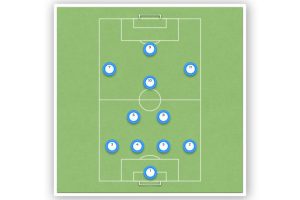Defending Against Fast Wingers: Tips for Fullbacks
I know that defending against fast wingers is one of the most challenging tasks on the pitch. These players are known for their speed, agility, and technical ability, making them a formidable opponent for any defender. However, with the right tactics and techniques, it is possible to effectively defend against them and prevent them from scoring.
The key to defending against fast wingers is to understand their strengths and weaknesses. Fast wingers are typically very quick on their feet and have excellent dribbling skills, which allow them to quickly change direction and evade defenders. However, they are often weaker in other areas, such as their ability to shoot accurately or their defensive capabilities. By identifying these weaknesses and exploiting them, you can effectively neutralize their threat and prevent them from scoring.
| Defensive Techniques | Advantages | Disadvantages |
|---|---|---|
| Containment | Prevents the winger from getting past you | May allow the winger to cross the ball into the box |
| Pressing | Forces the winger to make a mistake or lose the ball | May leave gaps in the defense if not executed properly |
| Double-teaming | Overwhelms the winger and limits their options | May leave other players unmarked or open |
Positioning and Awareness
As a fullback, my primary responsibility is to defend against fast wingers. To do this effectively, I need to have excellent positioning and awareness on the field. In this section, I will discuss two critical aspects of my defensive game: Defensive Positioning and Reading the Game.
Defensive Positioning
One of the most important aspects of defending against fast wingers is to have proper defensive positioning. This means that I need to be in the right place on the field to prevent the winger from getting past me. When positioning myself, I need to consider a few key factors:
- The position of the ball on the field
- The position of my teammates
- The position of the opposing team
- The speed of the winger
By taking these factors into account, I can position myself in a way that makes it difficult for the winger to get past me. For example, if the winger is on the left side of the field, I will position myself to their right, forcing them to either cut inside or cross the ball. Additionally, I need to be aware of the position of my teammates, so that I can provide cover if the winger manages to get past me.
Reading the Game
Another critical aspect of defending against fast wingers is the ability to read the game. This means that I need to be aware of what is happening on the field at all times, so that I can anticipate the movements of the winger. To do this effectively, I need to:
- Keep my head up and my eyes on the ball
- Be aware of the position of my teammates and the opposing team
- Anticipate the movements of the winger
By doing these things, I can anticipate the movements of the winger and position myself in a way that makes it difficult for them to get past me. For example, if I see the winger start to make a run down the flank, I can position myself to cut off their passing options and force them to either cut inside or cross the ball.
Summary
In summary, as a fullback, my primary responsibility is to defend against fast wingers. To do this effectively, I need to have excellent positioning and awareness on the field. By positioning myself correctly and reading the game effectively, I can make it difficult for the winger to get past me and help my team maintain possession of the ball.
| Key Points | Actions |
|---|---|
| Positioning | Consider ball position, team positions, and opponent positions. Provide cover for teammates. |
| Reading the Game | Keep head up, be aware of positions, anticipate movements of the winger. |
Tackling Techniques
Sliding Tackle
One of the most effective ways to tackle a fast winger is by using a sliding tackle. This technique is especially useful when the winger is moving at a high speed, and it is difficult to stop them with a standing tackle. When using a sliding tackle, it is important to time the tackle correctly to avoid a foul or a yellow card.
When executing a sliding tackle, I make sure to approach the winger from the side and slide in with my foot extended. I aim to make contact with the ball first and then follow through with the tackle. It is important to keep the arms close to the body to avoid a handball or a foul.
Standing Tackle
Another effective way to tackle a fast winger is by using a standing tackle. This technique is less risky than a sliding tackle and is often used when the winger is moving at a slower pace. When using a standing tackle, I make sure to approach the winger from the front and time the tackle correctly to avoid a foul or a yellow card.
When executing a standing tackle, I make sure to keep my body low and my feet shoulder-width apart. I aim to make contact with the ball first and then follow through with the tackle. It is important to keep the arms close to the body to avoid a handball or a foul.
| Tackling Technique | Advantages | Disadvantages |
|---|---|---|
| Sliding Tackle | Effective when the winger is moving at a high speed | Higher risk of a foul or a yellow card |
| Standing Tackle | Less risky than a sliding tackle | Less effective when the winger is moving at a high speed |
Communication with Teammates
Verbal Communication
As a fullback, it’s important to communicate with your teammates to defend against fast wingers. Verbal communication is an effective way to coordinate your defense and make sure everyone is on the same page. During the game, I make sure to communicate with my center backs and midfielders to ensure that we are all aware of the opposition’s attacking threats.
One way to communicate effectively is by using specific phrases and signals. For example, I often shout “man on” to alert my teammates that an opponent is closing in on them. I also use hand signals to indicate which direction I want my teammates to move or which player they should mark. By using clear and concise language, we can communicate quickly and efficiently on the field.
Non-Verbal Communication
In addition to verbal communication, non-verbal communication can also be effective in defending against fast wingers. By using body language and positioning, I can signal to my teammates where I need them to be on the field. For example, if I want my center back to move to the right, I might point in that direction or shift my body weight to that side.
Another way to use non-verbal communication is by making eye contact with your teammates. By looking at each other, we can quickly communicate without having to say anything out loud. This can be especially useful when defending against fast wingers, as we need to be able to react quickly and make split-second decisions.
| Verbal Communication | Non-Verbal Communication |
|---|---|
| Use specific phrases and signals | Use body language and positioning |
| Communicate quickly and efficiently | Make eye contact with teammates |
Overall, effective communication is key when defending against fast wingers. By using both verbal and non-verbal communication, we can coordinate our defense and limit the opposition’s attacking opportunities.
Physical Fitness and Conditioning
As a fullback, I know that physical fitness and conditioning are key factors in defending against fast wingers. In this section, I will discuss two sub-sections that will help you improve your physical fitness and conditioning: Speed and Agility, and Endurance.
Speed and Agility
To defend against fast wingers, you need to be quick on your feet and have good agility. One way to improve your speed and agility is by doing ladder drills. Ladder drills involve running through a ladder laid out on the ground with quick and precise footwork. You can also do cone drills, which involve running around cones in different patterns to improve your agility. Another important aspect of speed and agility is proper running form. Make sure to keep your head up, shoulders relaxed, and arms at a 90-degree angle while running. This will help you maintain good balance and reduce the risk of injury.
Endurance
Endurance is also crucial for fullbacks. You need to be able to run up and down the field for the entire game without getting tired. To improve your endurance, you can do interval training. Interval training involves alternating between high-intensity exercise and rest periods. For example, you can run at maximum speed for 30 seconds, then jog for 1 minute, and repeat. Another way to improve your endurance is by doing long-distance runs. This will help you build up your stamina and improve your cardiovascular health. Make sure to stretch properly before and after your runs to prevent injury.
Summary Table
| Physical Fitness and Conditioning | Training Methods |
|---|---|
| Speed and Agility | Ladder drills Cone drills Proper running form |
| Endurance | Interval training Long-distance runs Stretching |
Conclusion
As a fullback, defending against fast wingers can be a challenging task, but with the right approach, it can be done effectively. Throughout this article, I have shared some tips and strategies that have worked for me in the past. By staying focused, positioning yourself correctly, and communicating with your teammates, you can neutralize even the quickest of wingers.
One of the most important things to keep in mind is to never let the winger get behind you. By staying between the winger and the goal line, you can limit their options and force them to make a move. Additionally, it’s important to be aware of your surroundings and anticipate the winger’s next move.
Another effective strategy is to use your body to block the winger’s path. This can be done by positioning yourself in front of the winger and using your arms to block their progress. Just be sure to do so within the rules of the game.
| Key Takeaways |
|---|
| Stay between the winger and the goal line |
| Anticipate the winger’s next move |
| Use your body to block the winger’s path |
Finally, it’s important to work on your communication skills. As a fullback, you are an important part of the defense, and you need to be able to communicate effectively with your teammates. By letting them know where the winger is and what your plan is, you can work together to stop the attack.
Defending against fast wingers can be a daunting task, but with the right approach, it can be done effectively. By staying focused, positioning yourself correctly, and communicating with your teammates, you can neutralize even the quickest of wingers.






